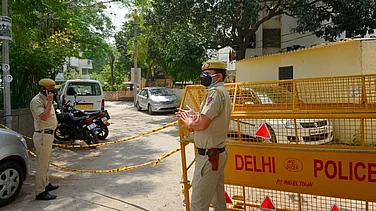The last two decades have witnessed a sanitation revolution in India. The Nirmal Bharat Abhiyan, launched in the early 2000s, laid the foundation for progress. Established in 2014, the Swachh Bharat Mission (SBM) represented a significant leap forward, bringing sustained attention and resourcing from the highest level of government leadership. Thanks to SBM’s mission-mode focus, it attracted participation from across the private sector, philanthropists and the media. Millions of toilets were constructed, and sanitation became a household topic.
Now that the basic infrastructure has been established, the focus of programmes, such as SBM 2.0 and other sanitation programmes, has shifted towards addressing the behavioural issue of encouraging people to consistently use toilets, responsibly manage waste and operate these systems in a self-sustaining and climate-resilient way. There has been significant progress in this regard, with almost 450,000 villages in India being proclaimed open defecation-free.
India is well poised to capitalise on this progress and deliver essential services to its citizens while ensuring resilience in the face of macro factors such as climate change, water risks, migration and other environmental factors. However, this will require a paradigm shift. When a system shifts from an infrastructure-heavy approach to a well-balanced systems approach, the workforce powering the system—in this case, the waste and sanitation economy—becomes crucial. We will require a strategic and thought-through approach to the sanitation workforce and human capital in the future.
Despite the gains, India’s vast sanitation workforce—the backbone powering this revolution—remains unrecognised and overlooked. When it does get attention, it is for the wrong reasons, such as worker deaths due to asphyxiation or overflowing sewer systems.
Sanitation and waste typically do not invite everyday discussion in India, either for evolutionary biology reasons (humans instinctively are averse to waste for health reasons) or culture. Consequently, the nature, the scale and the critical importance of the sanitation workforce need to be better understood. Public perceptions remain limited to stereotypical profiles like the “sewer cleaner” or the “rag picker”.
This enables the invisibilisation of millions of workers engaged in sanitation, concealing how discrimination and apathy have trapped them in poverty and limiting discourse on solutions to piecemeal interventions. Additionally, it drives a paucity in the imagination needed to address this issue at scale and transform sanitation and waste management work into a “profession”. For instance, narratives around “professionalisation”—such as those in manufacturing or MSME sectors—are entirely missing for waste and sanitation.
Our work at Dalberg, along with other partner organisations in India’s WASH ecosystem, has revealed that there are at least nine types of sanitation work in the ecosystem: cleaning sewers, collecting waste, operating treatment plants, maintaining public toilets and school toilets, cleaning institutional spaces such as railway stations, hospitals, cleaning sanitation infrastructure in homes and communities, and more. Our analysis from 2017–18 shows that almost five million people work in sanitation, of which at least two million work in high-risk settings.
The work continues to be deeply casteist (more than 90% of sanitation workers hail from Scheduled Castes) and gendered (women occupy some of the highest-risk roles within sanitation, are paid less than men and face frequent harassment). Caste-based occupations that pass down over generations trap families in cycles of poverty and perpetuate the discrimination and stigma that has historically excluded sanitation workers from public spaces, housing and education.
Sanitation workers also face significant health and economic problems. They are often underpaid and lack access to protective gear, training and medical care. Fatalities from asphyxiation in sewers and health impacts such as respiratory diseases, infections or trauma are common. The average lifespan of a sanitation worker is approximately 25 years less than the national average, according to the Safai Karamchari Andolan.
The government has put several schemes to address these challenges, such as the Prohibition of Employment as Manual Scavengers Act. However, these programmes need to go deeper or broader. For instance, under the National Safai Karamcharis Finance and Development Corporation (NSKFDC) programme, loans were given to only 13 sanitation workers in Gujarat and none in states such as Bihar and Madhya Pradesh in 2019–20. Further, safety regulations or minimum wage requirements are rarely enforced. Cash-strapped urban local bodies, for instance, often subcontract sanitation work to save costs and reduce compliance requirements under these regulations. This weak enforcement of safety regulations and minimum wage leaves informal workers vulnerable to exploitation.
India’s sanitation challenges are set to grow more complex, looking ahead. Climate change and extreme weather events will disrupt waste management services; rapid urbanisation and increasing volumes of waste will strain existing infrastructure, and e-waste and plastics will pose new environmental and health risks for workers and citizens. Addressing India’s waste management and sanitation needs while providing a decent and safe work environment for sanitation workers will require a fundamental act of reimagination of the sanitation work and economy.
We are at an inflexion point and nations, including India, are transitioning towards sustainability and circular economy models. For instance, India aims to eliminate single-use plastics and scale decentralised waste processing. Innovations in waste-to-energy, composting and digitisation are emerging. This transition will necessitate significant investments in infrastructure and the workforce and represents a promising opportunity to reimagine the future of sanitation work.
However, these shifts could also threaten to push millions of sanitation workers out of their livelihoods and leave them ill-equipped to deal with the technological changes. Here, it might be helpful to borrow from the climate justice lexicon the concept of a “just transition” to mitigate some of the shocks that result from the changes.
Based on our experience, we offer five principles to remember as the country moves forward.
Sanitation work is deeply heterogeneous. Visioning and planning processes must factor in this instead of taking a narrow view.
As a sector, waste and sanitation have the most significant variation in working conditions and the sophistication of technical solutions deployed. On the one hand, manual scavengers wade through thigh-deep sewage to either unclog drains or collect plastics they can resell. On the other, sophisticated waste-to-energy systems funded by large multinational corporations and venture capital investment carry out sophisticated chemical processes to treat waste, render it harmless and extract value from it. Thus far, most planning and visioning in waste and sanitation has treated these as two disconnected areas. In the future, the planning, visioning and budgeting processes must encourage technological innovation while investing in appropriate innovation to improve the safety and livelihoods of the sector’s most vulnerable workers.
Technological advancements, such as mechanised sewer cleaning and sophisticated protective gear, must be rolled out with comprehensive workforce training. This will be essential to ensure seamless adaptation and to avoid exacerbating existing social and economic disparities.
Formalising India’s sanitation workforce will be crucial and should involve large-scale skilling programmes and robust employment benefits. Roadmaps for skilling in sanitation work, such as the ones designed by the Water Management and Plumbing Skills Council (WMPSC) along with the National Council for Vocational Education & Training (NCVET) and National Skill Development Corporation (NSDC), will be critical in the future and will need to be deployed at scale, covering a wide range of roles in sanitation.

Transformation will have to be accompanied by provisions to safeguard jobs and livelihoods.
Widespread advocacy by well-meaning actors and organisations working in this space focuses on “ending manual scavenging”. However, expecting manual scavengers and informal sanitation labourers to abandon their existing work—no matter how hazardous or demeaning—without viable alternatives is not only unrealistic but also ethically questionable. A mandate will emerge to facilitate transitions for vulnerable workers into safer, formal roles aligned with the heterogeneous technical infrastructure roadmap described above.
This will necessitate targeted interventions that redress historical inequities, such as localised skills training, employment benefits and social security and healthcare access. Much like the structured support required for coal miners transitioning to green sectors, sanitation workers must carefully design public and private initiatives to move from traditional, caste-based roles to dignified employment in modern sanitation. Efforts such as the Harpic World Toilet College, which seeks to upskill and rehabilitate tens of thousands of sanitation workers, are a step in the right direction and should be scaled through partnerships with the private sector and governments.
Moreover, ensuring the representation of marginalised communities in policymaking will be crucial. Measures like access to credit and entrepreneurship support will also be instrumental.
Promoting community-owned business models will prevent elite capture of next-gen sanitation models.
As India shifts toward next-generation sanitation models centred on resource recovery and decentralised waste management, there is a risk of wealth capture by large economic interests bypassing community empowerment and collective ownership. Visioning and planning for the sector should elevate the role of communities traditionally engaged in sanitation labour and ensuring that the economic benefits flow primarily to them.
Community-owned business models will increasingly serve as vehicles for social mobility. Cooperatives, led by sanitation workers managing neighbourhood-level waste services, and self-help groups and unions that facilitate access to financing, skill development and entrepreneurship offer promising avenues. These worker-centric structures, when designed with care, will not only distribute dividends directly to workers but also grow local waste management ecosystems and local leadership. Public and private sectors must prioritise investments that empower workers in decision-making and wealth creation. This realignment will mitigate the risks of exploitative subcontracting and enable communities to transition from aid recipients to actors with agency and appropriate rewards.
Behaviour change and destigmatisation will be fundamental.
While integrated policy approaches, technological innovation and hybrid community-owned business models will be essential, genuine progress will only be made through targeting deep-seated social stigmas and prejudices that have historically marginalised sanitation workers in India. In an ideal world, sanitation work should not be relegated to specific caste identities and there should be sufficient mobility in and out of sanitation work.
Sophisticated behaviour change and awareness campaigns based on research and cutting-edge methods will induce generational shifts in attitudes and awareness. Media advocacy by political and civil society leaders must complement behaviour change efforts and have a critical role in constructing positive narratives about sanitation labour. Efforts by the Prime Minister Narendra Modi to draw attention to this issue are laudable and should be scaled.
Equally important will be diversifying representation in media. Conventional biases contribute to the misperception that these roles are “menial” and require minimal skill, ignoring the specialised expertise often needed to manage complex waste streams.
Framing sanitation work not just as a problem but as an opportunity will be critical.
For many years, sanitation work in India has predominantly been framed as a problem, simplistically viewed as only consisting of manual scavenging and assumed to be best addressed through the human rights and social justice approaches. While the gravity of these issues cannot be overstated, and human rights and social justice lenses continue to be critical, the dominance of this narrative has also narrowed collective imagination regarding sanitation work.
We must expand this approach, especially since the sector will require tens of thousands of crores in investments. Pivoting from a deficit-oriented viewpoint to recognising sanitation as a multifaceted domain, offering significant prospects for business innovation and social impact, will help the sector crowd in the resources required.
The evidence for this transformative potential already exists. Innovations that convert organic waste into biogas and compost solve waste management problems and create viable avenues for local entrepreneurship. The recent growth in faecal sludge treatment plants across Indian cities represents a fundamental opportunity to develop economic and health value through reduced environmental pathogen loads and decentralised waste markets. Furthermore, the expanding market for affordable sanitary products, such as pads, opens the door for micro-enterprises spearheaded by women’s self-help groups, further diversifying the opportunity landscape.
Centres such as the WASH Innovation Hub run by the Administrative Staff College of India represent essential innovations in catalysing the sanitation economy and should be scaled nationwide. Supported through an enabling policy environment and access to financial resources and skills training, sanitation workers have the potential to become small-scale entrepreneurs and innovators. They can actively contribute to steering their communities towards a circular economy, thereby contributing to a more sustainable and cleaner India.
The sanitation and waste sector will be fundamentally important for India in the future. We have both the moral obligation and the economic necessity of reimagining these sectors, especially the sanitation workforce’s role. The five fundamental shifts in visioning and planning described here can go a long way in creating an enabling environment for this shift and help India move towards a circular economy that is fair, productive and resilient.
Nirat Bhatnagar is a senior advisor and former partner, Dalberg Advisors.





















